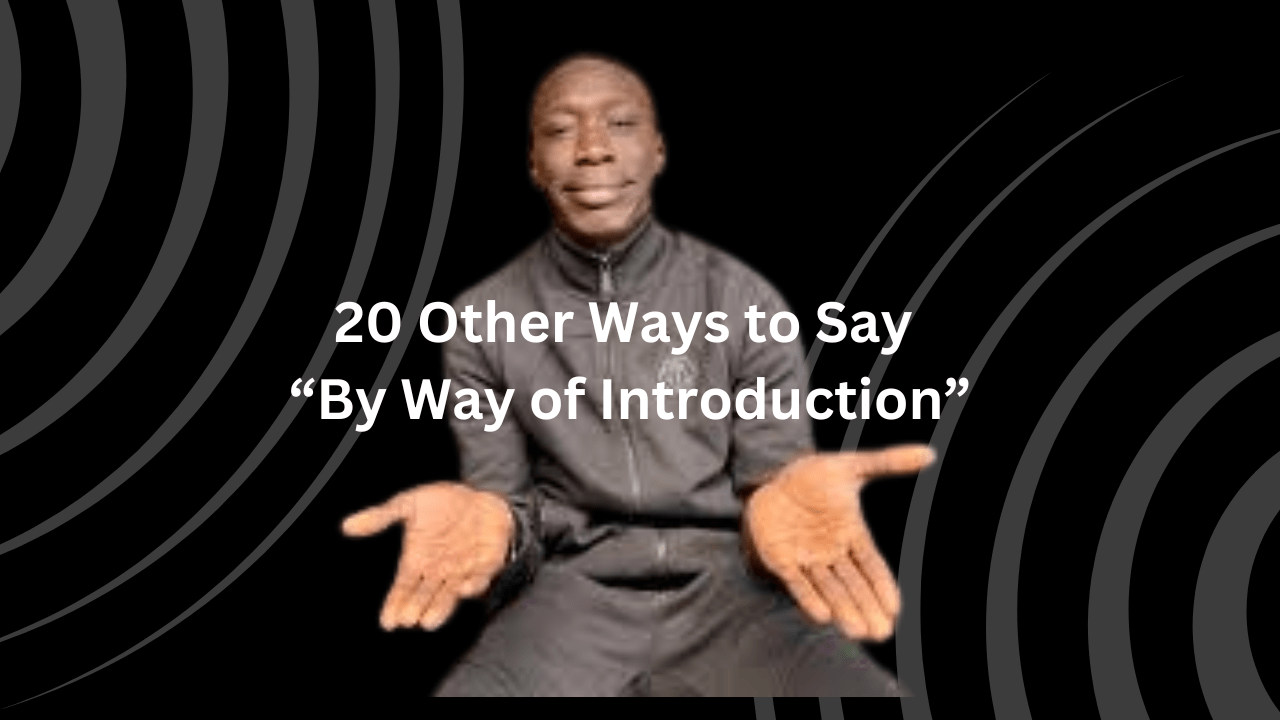If you’re seeking guidance on crafting a professional introduction for an email, this article is designed to assist you! Additionally, we’ve curated a selection of alternative of “By Way of Introduction” below to enhance your repertoire for introducing yourself with confidence and professionalism.
Other Ways to Say “By Way of Introduction”
- As an initial note
- To kick things off
- Permit me to introduce myself
- To commence
- By way of a formal introduction
- Allow me to start by saying
- As an opening statement
- To set the stage
- Let me begin by introducing myself
- As an introductory remark
- To inaugurate
- Let’s start off with
- To lay the groundwork
- To get things underway
- To preface my introduction
- As an opening gesture
- To initiate our conversation
- Let me outset by saying
- To commence proceedings
- As a preamble
As an initial note:
This phrase serves as an introductory remark indicating that the speaker is about to begin their introduction. It sets the stage for what follows, signifying that the subsequent information will be the first point or observation made in the introduction.
“As an initial note” conveys a sense of formality and structure, ensuring that the recipient understands that the introduction is about to commence.
To kick things off:
This informal expression is used to signal the beginning of the introduction in a casual or friendly manner. It conveys a sense of enthusiasm and momentum, suggesting that the speaker is eager to start the conversation.
“To kick things off” is often employed in less formal settings where a relaxed and approachable tone is appropriate, such as in informal emails or conversations.
Permit me to introduce myself:
This formal phrase is employed to request permission from the recipient to proceed with the introduction. It demonstrates politeness and respect for the recipient’s attention, indicating that the speaker recognizes the importance of initiating the introduction with permission.
“Permit me to introduce myself” is commonly used in professional or formal contexts, such as business emails or networking events, to establish a courteous and respectful tone.
To commence:
This formal term is utilized to denote the initiation or beginning of the introduction. It conveys a sense of formality and seriousness, indicating that the speaker is about to start providing information about themselves.
“To commence” is often employed in situations where a high level of professionalism is expected, such as in academic or business settings, to ensure clarity and precision in communication.
By way of a formal introduction:
This expression indicates that the speaker is about to provide a formal introduction of themselves. It emphasizes the structured and official nature of the forthcoming introduction.
“By way of a formal introduction” is commonly used in professional settings or when the speaker wants to ensure that the introduction is conducted with a degree of formality and professionalism.
Allow me to start by saying:
This phrase is used to politely request permission to begin the introduction. It conveys a sense of respect for the recipient’s attention and indicates that the speaker is about to share information about themselves.
“Allow me to start by saying” is often used in formal or semi-formal contexts where the speaker wants to establish a courteous and respectful tone.
As an opening statement:
This expression signifies that the information provided will serve as the initial statement or remark in the introduction. It conveys a sense of importance and significance, suggesting that the speaker is starting the introduction with a key point or observation.
“As an opening statement” is commonly used in formal or professional settings to ensure that the introduction begins with clarity and purpose.
To set the stage:
This phrase is used to prepare the listener for the introduction by creating context or providing background information. It conveys a sense of readiness and anticipation, indicating that the speaker is about to lay the groundwork for the introduction.
“To set the stage” is often employed when the speaker wants to ensure that the listener understands the context or purpose of the introduction before proceeding.
Let me begin by introducing myself:
This expression straightforwardly indicates that the speaker is about to provide an introduction of themselves. It conveys a direct and clear intention to start the introduction without preamble.
“Let me begin by introducing myself” is commonly used in various contexts, both formal and informal, to initiate introductions with clarity and precision.
As an introductory remark:
This phrase signals that the following information will serve as the first remark or observation in the introduction. It emphasizes the introductory nature of the forthcoming statement, indicating that it will provide context or set the tone for the rest of the introduction.
“As an introductory remark” is often used to ensure that the listener understands the purpose or focus of the introduction from the outset.
To inaugurate:
This formal term signifies the commencement or initiation of the introduction. It conveys a sense of ceremony and importance, suggesting that the speaker is formally beginning the process of introducing themselves.
“To inaugurate” is often used in formal contexts, such as speeches or presentations, to mark the formal beginning of an event or discourse.
Let’s start off with:
This phrase is used to suggest beginning the introduction with a particular point or aspect. It conveys a sense of direction and purpose, indicating that the speaker has a specific starting point in mind for the introduction.
“Let’s start off with” is commonly used in casual or informal settings to guide the listener’s attention to the initial topic or subject of the introduction.
To lay the groundwork:
This expression is used to indicate that the speaker is preparing to provide essential background information or context for the introduction. It conveys a sense of preparation and planning, suggesting that the speaker is laying the foundation for what will follow in the introduction.
“To lay the groundwork” is often employed when the speaker wants to ensure that the listener understands the background or context necessary for the introduction to be fully understood.
To get things underway:
This phrase signals the beginning or initiation of the introduction. It conveys a sense of readiness and anticipation, indicating that the speaker is prepared to start the introduction without delay.
“To get things underway” is commonly used in informal or casual settings to signal the start of an activity or event, including introductions.
To preface my introduction:
This expression indicates that the speaker is about to provide an introductory statement or explanation before proceeding with the main introduction. It conveys a sense of preparation and organization, suggesting that the speaker is setting the stage for what will follow.
“To preface my introduction” is often used to ensure that the listener understands the context or purpose of the introduction before it begins.
As an opening gesture:
This phrase signals that the speaker is about to make an initial, often symbolic, action or statement to begin the introduction. It conveys a sense of formality and significance, indicating that the speaker is marking the beginning of the introduction with a particular gesture or remark.
“As an opening gesture” is commonly used in formal or ceremonial contexts to signal the start of an event or discourse.
To initiate our conversation:
This expression indicates that the speaker is about to start the introduction as the first step in beginning a conversation with the listener. It conveys a sense of purpose and direction, suggesting that the speaker is intentionally starting the conversation with an introduction.
“To initiate our conversation” is often used to establish a conversational tone and invite the listener to engage in further dialogue.
Let me outset by saying:
This phrase indicates that the speaker is about to begin the introduction with a particular statement or observation. It conveys a sense of directness and clarity, suggesting that the speaker is starting the introduction with a specific point in mind.
“Let me outset by saying” is commonly used to ensure that the listener understands the speaker’s intentions from the outset of the introduction.
To commence proceedings:
This expression signals the formal beginning of an event, process, or discourse, including the introduction. It conveys a sense of formality and ceremony, indicating that the speaker is formally initiating the proceedings.
“To commence proceedings” is often used in formal contexts, such as legal or ceremonial events, to mark the beginning of an activity or event.
As a preamble:
This phrase indicates that the speaker is about to provide introductory remarks or statements before proceeding with the main content of the introduction. It conveys a sense of preparation and organization, suggesting that the speaker is providing essential context or background information.
“As a preamble” is commonly used in formal or academic settings to introduce a written document or speech, providing context for the main content that follows.










